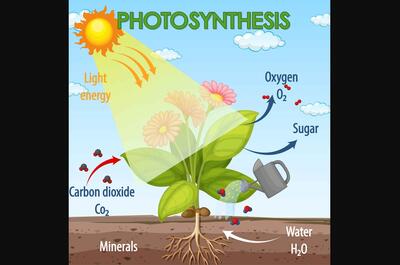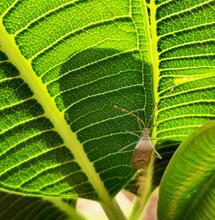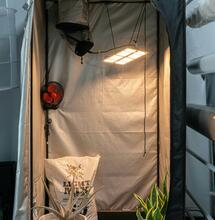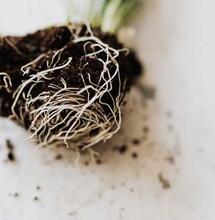.png)
If you’ve ever tried to choose the right grow light for your plants, you’ve probably come across terms like Lux, Lumen and P.A.R. — and maybe wondered what they really mean. Among new cannabis growers especially, there’s still a lot of confusion about what makes a grow light truly efficient.
Many people still think brightness equals power, but that’s not how plants see light.
Human eyes and plant leaves speak completely different “languages” when it comes to light.
This guide will finally clear things up — explaining what P.A.R. really is, why Lux and Lumen can be misleading, and how to use the right metrics (like PPFD and DLI) to grow stronger, healthier plants.
And since we like to keep things real, we’ve included the opinions of two experts who helped shape the Italian cannabis scene — Dr. Alessandro Peretti (Indoorline) and Filippo “Filo” Vona (Grow Shop Italia),( do follow) pioneers who have been studying plant lighting and cultivation since 2003.
What is PAR (Photosynthetically Active Radiation) and why is it vital for cannabis?
P.A.R. stands for Photosynthetically Active Radiation.
It refers to the specific part of the light spectrum — between 400 and 700 nanometers — that plants actually use for photosynthesis.
In simple terms, P.A.R. is the portion of visible light that fuels growth. It’s not a measurement like Lux or Watt, but a concept: it tells us which wavelengths matter for plant development.
Here’s how that breaks down:
- Blue light (400–500 nm) encourages leafy growth, short internodes and chlorophyll production.
- Red light (600–700 nm) triggers flowering and fruiting, influencing hormonal processes inside the plant.
Light outside that range — like UV or infrared (IR) — can affect the plant’s color, shape or resin production, but it doesn’t directly power photosynthesis.
Modern LED grow lights are designed to focus as much electrical energy as possible into this P.A.R. range — which is why they’re far more efficient than older HID or fluorescent lights.

Lux and Lumen: Why they are not reliable metrics for cannabis lighting
Let’s be clear: Lux and Lumen measure how bright a light looks to humans, not how useful it is to plants.
Lumen is the total amount of light perceived by our eyes. Lux is simply lumen per square meter.
But our eyes are most sensitive to green light — around 555 nm — while plants mainly use blue and red.
So a light that looks super bright to you might actually be wasting energy from the plant’s point of view.
That’s why using Lux or Lumen to judge a grow light’s strength is like trying to measure temperature with a ruler — it just doesn’t make sense.
PPFD: The key metric for measuring useful light in cultivation
Here’s the one that counts: PPFD, short for Photosynthetic Photon Flux Density.
It measures how many useful light particles (photons) hit one square meter of your canopy each second — expressed in µmol/m²/s.
This tells you the real intensity of light your plants are getting.
The higher the PPFD (within a safe range), the faster and more efficiently your plants can photosynthesize and grow.
Too little PPFD means slow growth and stretching; too much can stress plants or cause “light burn.”
The key is finding balance — strong, even light with proper airflow, CO₂ and nutrition.
.jpg)
DLI (Daily Light Integral): Optimizing the daily amount of light for cannabis
While PPFD measures intensity at a given moment, DLI (Daily Light Integral) tells you how much total light your plants receive in a full day.
It combines both the light’s strength and the duration it’s on — and it’s measured in mol/m²/day.
Example:
If your grow light delivers 600 µmol/m²/s for 18 hours a day, that’s roughly 38 mol/m²/day — a sweet spot for the vegetative stage of most cannabis strains.
During flowering (12 hours of light), you can increase intensity to maintain a similar DLI.
In short: DLI helps you plan your lighting schedule like a pro.
Full spectrum light: Impact on cannabis morphology and yield
Light quality isn’t only about brightness — it’s also about color composition, or spectrum.
Today’s best full spectrum LED grow lights mimic the natural sunlight spectrum, giving plants everything they need through every stage of life.
Here’s how spectrum plays out:
- Veg stage: more blue = compact, strong, leafy growth.
- Flowering: more red = denser buds and heavier yields.
- Finishing: small doses of UV and IR can enhance resin and terpene production.
That’s why “full spectrum” isn’t just marketing buzz — it’s one of the biggest reasons LEDs outperform traditional HPS lights in modern indoor grows.
The value of PAR according to experts in indoor cannabis cultivation
According to Dr. Alessandro Peretti and Filippo “Filo” Vona, two of Italy’s top cultivation consultants, understanding light science is what separates hobbyists from real growers.
“When a grower learns the difference between light we see and light plants use, everything changes.
It’s not just about getting more yield — it’s about getting smarter and more sustainable.”
— Dr. Alessandro Peretti (Indoorline)
“Stop trusting lumen values and start looking at PPFD and DLI.
That’s the language plants actually understand.”
— Filippo “Filo” Vona, Grow Shop Italia
How to choose LED lamps for cannabis cultivation based on PAR and efficiency
When comparing grow lights, forget the flashy specs and look at what really matters:
- PPFD across the whole canopy — not just the center.
- Light uniformity — even coverage means even growth.
- Spectrum quality — make sure it’s a real full spectrum for all stages.
- Photon efficiency (µmol/J) — shows how much usable light the lamp produces per watt. Anything above 2.5 µmol/J is excellent.
And most importantly: if a manufacturer only lists Lux or Lumen, it’s a red flag — they’re not measuring what plants actually need.
Lighting Calibration: Intensity and Photoperiod for Cultivation
Once you’ve got the right light, you still need to dial it in:
- Adjust the distance between the light and canopy to control PPFD.
- Use dimmers or spectrum controls if available to fine-tune color and intensity.
- Match photoperiods — 18/6 for veg, 12/12 for bloom.
- Balance your environment: more light means you’ll also need proper CO₂, nutrients, humidity and airflow.
Growing with precision isn’t about spending more — it’s about understanding how all these factors work together.
The Future of LED Lighting in Cultivation: Efficiency and Smart Control
LED technology keeps getting smarter.
We’re already seeing lights with auto-adjusting spectra, PPFD sensors, and smart controllers that respond to real-time plant needs.
The trend is clear: more yield, less energy, and total control for the grower.
The next era of grow lighting will be about data-driven cultivation — precision, sustainability and repeatable results.
Conclusion
Knowing the difference between Lux, Lumen and P.A.R. changes everything.
Once you start working with PPFD and DLI, you stop guessing and start growing with science.
For plants, light isn’t about brightness — it’s about usable energy.
Learn to measure it right, and you’ll unlock healthier growth, better yields and a more efficient grow room.



